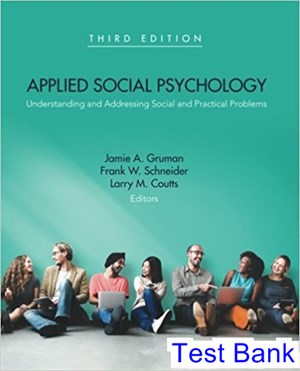This is completed downloadable of Applied Social Psychology Understanding and Addressing Social and Practical Problems 3rd Edition Gruman Test Bank

Product Details:
- ISBN-10 : 1483369730
- ISBN-13 : 978-1483369730
- Author: Jamie A. Gruman, Frank W. Schneider, Larry M. Coutts
This student-friendly introduction to the field focuses on understanding social and practical problems and developing intervention strategies to address them. Offering a balance of theory, research, and application, the updated Third Edition includes the latest research, as well as new, detailed examples of qualitative research throughout.
Table of Content:
- PART I Foundations of Applied Social Psychology
- 1. Defining the Field of Applied Social Psychology
- Social Psychology
- Defining Social Psychology
- Social Psychology as a Science
- Applied Social Psychology
- Applied Social Psychology as a Science
- The Role of Personal Values
- Historical Context of Applied Social Psychology
- A Problem Focus
- Approaches to Applied Social Psychology
- Social Influences on Behavior: The Power of the Situation
- Levels of Analysis
- The Need for a Broad Approach
- Various Roles of Applied Social Psychologists
- Overview of Book
- Summary
- 2. Social Psychological Theory
- The Scientific Process
- Theory in Social Psychology
- Functions of Social Psychological Theories
- Characteristics of Social Psychological Theories
- Cognitive Dissonance Theory
- Description
- Organization
- Direction
- Intervention
- Summing Up Cognitive Dissonance Theory
- Theory of Planned Behavior
- Description
- Organization
- Direction
- Intervention
- Summing Up the Theory of Planned Behavior
- Summary
- 3. Research Methods in Applied Social Psychology
- Methods of Data Collection
- Variables and Their Measurement
- Self-Report Methods: The Special Case of Surveys
- Observational Methods
- Research Designs
- True Experiments
- Quasi-Experiments
- Correlational Studies
- Descriptive Studies
- Research Settings
- Qualitative Research Methods
- Research Ethics
- Postscript
- Summary
- 4. Intervention and Evaluation
- Design of Interventions
- Nature of Interventions
- Key Tasks in Intervention Design and Delivery
- Evaluation of Interventions
- Reasons for Evaluating Interventions
- Ineffective Interventions
- Types of Evaluation
- Importance of Research Design in Evaluating Interventions
- Evidence-Based Interventions
- An Intervention Example: Reducing Alcohol Problems on Campus
- Identifying the Problem
- Developing a Solution: Forming the Intervention Hypothesis
- Goal Setting and Designing the Intervention
- Implementing the Intervention
- Evaluating the Intervention
- Incorporating Qualitative Methods to Design and Evaluate Interventions
- Further Applications of Social Norm Theory
- Other Interventions
- Examples of Other Interventions
- Complex Problems Require Complex Solutions
- Influencing Social Policy
- Intervention Issues
- Process Issues
- Ethical Issues
- Summary
- PART II Applying Social Psychology to Arenas of Life
- 5. Applying Social Psychology to Clinical and Counseling Psychology
- The Origins of Psychological Disorders
- The Social Psychological Roots of Social Anxiety
- A Social Psychological Model of Depression
- The Treatment and Prevention of Psychological Disorders
- Self-Presentation Theory: An Approach to Treating Social Anxiety
- Hopelessness Theory Approach to Treating Depression
- The Diagnosis of Psychological Disorders
- Biases in Clinical Decision Making
- Final Thoughts
- Summary
- 6. Applying Social Psychology to Sports Teams
- Team Dynamics
- Team Cohesion
- Team Confidence
- Effective Communication
- Team Goal Setting
- Team Building
- Family Psychology Intervention
- Communication Training Intervention
- Summary
- 7. Applying Social Psychology to the Media
- How Does Media Violence Affect Us?
- The Consequences of Viewing Media Violence
- Imitation of Violence
- Media Violence and Aggressive Thoughts
- Media Violence and Fear
- What Happens When We Watch Pornography?
- Effects of Long-Term Exposure to Nonviolent Pornography
- Effects of Exposure to Embedded Violent Sexual Material
- Reducing the Harmful Effects of Exposure to Violent Sexual Material
- Does Political News Coverage Affect Us?
- How the Media Influence Our Thoughts
- Effects of Negative Media Coverage of the Government
- Summary
- 8. Applying Social Psychology to Health
- Health Psychology Defined
- The Biopsychosocial Model
- Social Variables and Health
- Promoting Health and Preventing Illness
- Persuasion and Social Influence in Media Health Coverage
- Health Literacy: Evaluating Health-Related Information on the Internet
- Family, Peer, and School Influences
- Changing Health Behavior
- Health Belief Model
- Theory of Planned Behavior
- Transtheoretical Model
- Stress, Coping, and Social Support
- Stress and Coping
- Social Support
- Summary
- 9. Applying Social Psychology to Education
- Intrapersonal Processes: Increasing Success, Reducing Failure
- What Factors Affect Student Performance?
- How Can Student Performance Be Improved?
- Interpersonal Processes: Teachers and Students Interacting
- Teacher Expectations and Student Achievement
- Students Interacting With Other Students
- When Interactions Turn Ugly: Aggression in School
- Summary
- 10. Applying Social Psychology to Organizations
- The Individual in an Organizational Context
- Making Sense of Others in the Work Environment
- Job Satisfaction: Antecedents and Consequences
- Interpersonal Processes in Organizations
- Communication
- Group Decision Making
- Summary
- 11. Applying Social Psychology to the Criminal Justice System
- The Crime and the Criminal
- The Social Psychology of a Crime
- The Origins of Criminal Behavior
- The Response of the Criminal Justice System
- The Police Investigation
- The Courtroom
- The Prison Setting
- Summary
- 12. Applying Social Psychology to the Community
- What Is Community Psychology?
- Defining Community Psychology
- Origins of Community Psychology
- Community Psychology Values and Approaches
- Sense of Community
- Life in the City
- The Internet as a Community and Source of Help
- Diversity Versus Prejudice and Stigmatization
- The Importance of Diversity
- Research on Stigmatization
- The Media and Stigmatization
- Bringing About Social Change
- Social Action and Activism
- Using Research to Influence Social Change
- Activism in Research
- Influencing Policy
- Changing Structural or Social Barriers
- Summary
- 13. Applying Social Psychology to the Environment
- Resource Dilemmas
- A Family of Dilemmas
- What Is a Resource Dilemma?
- Studying Resource Dilemmas
- Strategies for Inducing Pro-Environment Behavior
- The Built Environment
- Social Design
- Defensible Space
- Epilogue
- Summary
- 14. Applying Social Psychology to Diversity
- Societies: Cultural Diversity
- Hofstede’s Cultural Taxonomy
- Schwartz’s Values Framework
- Social Axioms Approach
- Demographics: Personal Diversity
- Gender
- Ethnic Background
- Social Class
- Consequences of Diversity: Opportunities and Challenges
- Creativity and Innovation
- Problem Solving
- Prejudice and Discrimination
- Conflict
- Theories of Conflict
- Conflict Management and Resolution
- Summary
- PART III Applying Social Psychology to One’s Own Life
- 15. Applying Social Psychology to Personal Relationships
- The Need to Be Close
- Attraction
- Proximity and Familiarity
- Physical Attractiveness
- Attachment
- Infant Attachment
- Adult Attachment Styles
- Assess Your Attachment Style
- Applying Attachment Lessons
- The Selection Process
- The T-Shirt Study
- Selection Process Lessons and Applications
- Conclusion: The Science of Closeness
- Summary
- 16. Applying Social Psychology to the Classroom
- Cognitive Errors and Student–Teacher Relations
- Fundamental Attribution Error
- Belief Perseverance
- Social Categorization
- Self-Perceptions and Their Academic Consequences
- Self-Handicapping
- Self-Serving Bias
- Overjustification Effect
- Conclusion: Social Psychology in the Classroom
- Summary
- 17. Applying Social Psychology to the Good Life: Balancing Optimism and Pessimism
- Introduction to Positive Social Psychology
- Optimism
- Introduction to Optimism–Pessimism
- Self-Assessment of Optimism–Pessimism
- The Social Psychology of Optimism
- The Benefits of Optimism
- Positive Coaching Exercises
- Pessimism
- A Balanced View of Optimism and Pessimism
- Broadening the Perspective on Well-Being
- Summary
- References
- Author Index
- Subject Index
- About the Editors
- Contributors





